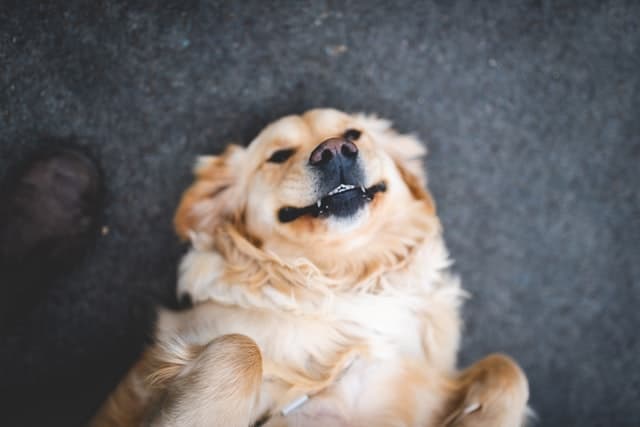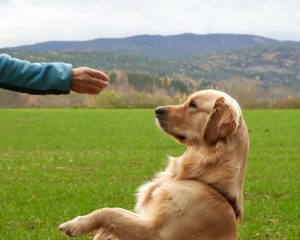Golden retriever puppy development includes many stages and critical moments during which puppies reach adulthood.
Contents
Whether you're wondering when your puppy will calm down and stop biting everything or just curious about what puppies go through to become adult dogs, this puppy timeline has the answers you're looking for.
First teeth in a dog - when do they appear?

Puppies - just like babies - are born without teeth. Their first teeth begin to erupt around 3-4 weeks of age. These are the incisors. A puppy's teeth are small and sharp and are close together. Around the age of 5-6 weeks, the puppy's canines begin to erupt, and at the period of 6-9 weeks, the puppy should already have a set of milk teeth or 28 teeth in total.
At about four months of age - and this period can vary depending on the breed and dog - the 28 puppy teeth are replaced by 42 adult canine teeth, including molars.
You need to know that the eruption of teeth is not pleasant for your dog - it can hurt him, itch, and he can feel discomfort, and as a result, he can bite everything he encounters on his way. That's why it's a good idea to buy him a chew designed for puppies and matched to the size of your pet's breed. Biting and chewing the toy should bring him relief.
Golden Retrievers stop teething at six to eight months of age. After that, they will continue to chew, bite, and gnaw, but at this age, all puppy teeth have been replaced by adult teeth.
Puppy dental check-up

Check your puppy's mouth every few days to see how his teeth are doing. Check whether all the baby teeth have grown in, whether they are starting to fall out, and whether the permanent teeth are coming in place of the baby teeth.
Check that they are growing straight and that the permanent teeth are not growing next to the baby teeth - this is called "permanent baby teeth," and they are not falling out, even though their permanent counterparts have grown in. React if you notice any irregularities.
It's worth discussing all your doubts with your vet, who will be able to see the puppy's teeth, e.g., on the occasion of vaccinations against infectious diseases. With a puppy up to 3 months of age, you should come to the vet clinic at least a few times for vaccinations to develop proper immunity, so it's an excellent opportunity for a specialist to do a dental check-up for your dog.
How many milk teeth does a dog have?
A puppy has 28 milk teeth. 14 of them are located in the jaw and 14 in the mandible. The upper and lower dental arch has 3 incisors, 1 fang, and 3 premolars on each side. However, it does not yet have molars, which are the teeth that are deepest in the mouth.
Replacement of deciduous teeth in a dog
When a dog has complete teeth

The replacement of teeth in a dog from milk to permanent teeth begins at 3-4 months of the pet's life and should be completed when the dog is roughly 7-9 months old. The tooth replacement process usually begins with the incisors and ends with the eruption of the molars. How many teeth does an adult dog have?
An adult dog has 42 teeth, of which 22 teeth are located in the jaw and 20 in the mandible. However, you need to know that the number of teeth can vary from one individual to another - some dogs may have more teeth and others less. Perhaps the extra tooth is a milk tooth that did not fall out during tooth replacement (surviving milk tooth). Such a situation should be consulted with your veterinarian immediately.
Curved bite in a dog

The correct bite in dogs is a scissor bite (in some dogs, a so-called claw bite is allowed). An abnormal bite is considered a forebite and a backbite, although a forebite is permitted in some brachycephalic breeds of dogs, such as French bulldogs. Malocclusions can be passed on genetically to offspring or acquired, such as from improper tug or chew play.
How to care for your dog's teeth?

Tooth and periodontal disease and the accompanying foul odor from the dog's mouth are very common among pets. Fortunately, they can be effectively prevented by following a canine oral prevention program. Prevention includes regular brushing and choosing the right dog food that won't encourage debris to settle on their teeth, using dental treats, and visiting a veterinary clinic for check-ups.
Dog teeth are much less prone than human teeth to decay, which is the most common cause of human dental visits. In dogs, it's tartar and periodontitis that are the most extensive dental problems, weakening not only the teeth themselves but also the gums.
Brushing your dog's teeth

Veterinarians recommend that you brush your dog's teeth daily. Irregular brushing, brushing every other day or only a few times a week is not enough - in prevention, the most important thing is regularity. In pet stores and veterinary clinics, you can get dog toothpaste and special toothbrushes (with a single or double head), finger caps ending in a brush, and cleaners.
Never use toothpaste designed for humans on dogs. Such products have too much fluoride, which can cause your pet poisoning. They may also contain xylitol, which is toxic to dogs. Brush your dog's teeth from the first day in your home. This is the most effective way to prevent plaque and tartar buildup on teeth.
Start brushing your dog's teeth as early as possible. An adult or older dog that has never brushed its teeth will probably need much more time than a puppy to get used to this activity, but it's better to start later than never. It's worth motivating not only your dog but for yourself as well and making brushing your dog's teeth a daily ritual.
Of course, at first, your dog won't want to cooperate with you - it will pull away and make the task more difficult. Don't give up and consistently familiarize your dog with the new activity. Your dog will eventually get used to it. Remember to reward him when he stays calm and rewards him every time he allows himself to brush his teeth. This is a significant part of motivating your pet to cooperate.
The first step is to get your dog used to you touching his mouth, especially his lips. You can introduce him to the smell of the toothbrush and dog toothpaste simultaneously. Apply a small amount of toothpaste to his teeth and try to spread it around.
You don't have to use a toothbrush or cleaner yet. The idea is to get your pet familiar with the new taste, smell, and ritual. If he stays calm, don't forget to reward him with a favorite toy or dog treat.
In time, you can start brushing the front teeth, or incisors, with a finger cap with a toothbrush or with a cleaner (swab). Start with the outside, or cheek side. Once the dog is accustomed to the new situation, you can start cleaning the teeth on the inside and move on to cleaning the cheek teeth. In dogs already used to the new ritual, it is worth using a brush with a double head, which will remove plaque from the surface of the dog's teeth even more effectively.
The technique for brushing dog teeth is the same as brushing human teeth. You should clean your pet's teeth on all sides, not forgetting those hidden deep in the mouth, i.e., the premolars and molars. If you have doubts that you're doing it right, you can ask your veterinarian to give you valuable tips for your pet's oral hygiene.
When puppies mature and calm down

Puppies typically reach an adult dog's emotional maturity and temperament between twelve and eighteen months of age. However, they may continue to occasionally exhibit puppy-like behaviors, such as chewing and biting, until about two years of age.
Generally, by the time a puppy reaches eighteen months of age, he should have a stable adult personality and be fully acclimated to his place in the family. However, that doesn't mean he won't still be bursting with energy! Depending on the dog, this can take up to several years, so regular exercise and training are so important to help them learn appropriate behaviors.
Typical puppy development comes with some challenges, which most often test the patience of fresh-faced furry owners. But watching a puppy develop from birth to adulthood is rewarding and fun.
Tooth loss in an old dog
How to take care of senior dogs' teeth?

You should take care of older dogs in the same way as the teeth of younger pets - first of all, brush them regularly and react if tartar begins to build upon their surface.
Adapt the structure of the food to the condition of the teeth. If your dog suddenly walks away from the bowl or squeaks while eating dry food, it may be a sign that he is experiencing soreness in his mouth due to periodontal disease.
In such a case, it is necessary to visit a veterinary doctor, who will assess what hurts the dog. For the duration of the treatment, it's a good idea to stop giving your dog dry food and use wet food in a can, sachet, or tray.
Why do old dogs' teeth fall out?

The teeth of senior dogs and ancient dogs are weaker than healthy adult dogs' teeth. They tend to accumulate plaque on their surface, which promotes tartar buildup, which weakens the teeth and the gums where the teeth are rooted.
The tissues surrounding the teeth are more susceptible in older dogs to periodontitis, or periodontitis, which manifests itself by, among other things, receding gums, resulting in tooth loss.




